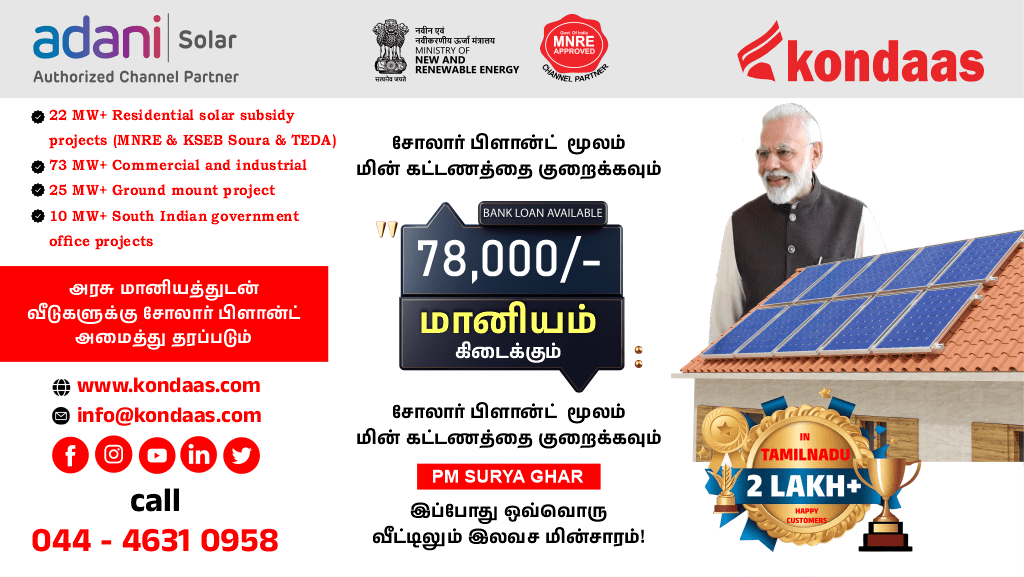PM Surya Ghar Muft Bijli Yojana (MRNE SOLAR SUBSIDY)
The central government is focusing on renewable energy and promoting it among people by launching multiple welfare schemes related to solar energy. The Central government has also released the specific budget for running solar renewable energy schemes including solar rooftop scheme, Pradhan Mantri Suryoday scheme, PM Surya Ghar Muft Bijli Yojana 2024 etc. These schemes provide subsidies on the cost of installing solar panels. The government has discussed about PM Surya Ghar Muft Bijli Yojana 2024 recently, so today we will discuss with you the latest updates of PM Surya Ghar Muft Bijli Yojana 2024 in this article including the application procedure in the scheme, eligibility criteria, important document list, maximum Subsidy amount etc.
The Prime Minister of India Narendra Modi released the PM Surya Ghar Muft Bijli Scheme on 13 February 2024 by announcing it on the social media platform Twitter. The government will conduct awareness programs about the scheme where beneficiaries will get a subsidy of a Maximum of 75% amount in the installation of solar panels. The scheme will be provided into multiple variants including subsidy for 1-kilowatt solar panels, subsidy for 3 km solar panel and 5-kilowatt solar panels, etc. It is expected by the government to include up to 1 crore beneficiaries under the scheme. However, the PM Surya Ghar Muft Bijli Yojana 2024 will ensure solar energy and will help to save money for Indian citizens from electricity bills as they can get up to 300 units of free subsidy per month by installing solar panels under PM Surya Ghar Muft Bijli Yojana Registration 2024.
PM Surya Ghar Muft Bijli Yojana Solar Subsidy Scheme
The cost of installing Solar Panels is very high, so most of the middle class and lower class cannot afford the cost of solar panels. It goes approximately 1 lakh to 1.5 Lakh according to the condition and the company of solar panels. However, the scheme provides subsidies into two categories including subsidy for 1 kilowatt solar panel and 3 Kilowatt solar panels.
If you are installing 1 kilowatt solar panel then you will get maximum Rs 30000 subsidy & for 2 Kilowatt you will get maximum subsidy of Rs 60000 under the PM Surya Ghar Muft Bijli Yojana 2024,
However if you are installing for 3 Kilowatt solar panel then you will get maximum 78000 subsidy.
If you’re specifically looking for details on how the MNRE subsidy is being implemented in Kerala in 2025, including approved vendors and installation costs, you can read the full breakdown here.
Cost of installation of solar panel under PM Surya Ghar Scheme 2024
There are multiple types of solar panels available in the market. Solar panels for 1 KW are available in the market from the range of 90000 to 1 lakh rupees according to the facilities and warranty period. If you are looking for a 2 kilowatt solar panel then you have to spend approximately 1.30lakh to 1.50lakh . The three-kilowatt solar panel will be beneficial for those who have multiple floors and large consumption of electricity and they can prepare a budget for 1 lakh rupees to 2.40 Lakh for 2.65Lakh Kilowatt solar panels. However, once you get the subsidy from the company then the cost of the installation of solar panels will automatically reduce.
PM Surya Ghar Muft Bijli Yojana 2024 Eligibility
Only Indian citizens can apply for PM Surya Ghar Muft Bijli Scheme 2024.
You should have a proper space for installation of solar panel on the rooftop on the house where the sunlight should appear regularly.
The applicant should have electricity connection from any electricity providing company
As government is promoting the installation of solar panel, so applicant should not engaged in any other Central or state sponsored solar installation scheme for subsidy.
Apart from this you should also have proper documents including the ownership documents of the house, electricity bill, Aadhar card, bank account details etc to install the solar panel.
Frequently Asked Question
1. What is MNRE?
The Ministry of New and Renewable Energy (MNRE) is a government agency in India responsible for formulating policies and programs to promote renewable energy sources such as solar, wind, biomass, and hydro power.
2. How is the Subsidy Paid?
The subsidy is typically paid through direct transfer to the bank account of the eligible beneficiary or project developer. Alternatively, it may be reimbursed based on proof of eligible expenses incurred during project implementation. In some cases, subsidies may also be provided in installments or routed through financial institutions administering the subsidy program on behalf of the government. The specific payment mechanism depends on the subsidy scheme, government regulations, and the nature of the renewable energy project.
3. How much area is required for a 1 kW rooftop Solar PV system?
The area required for a 1 kW rooftop Solar PV system typically varies depending on several factors such as the efficiency of the solar panels, the tilt angle of the roof, shading, and local weather conditions. As a rough estimate, a 1 kW rooftop solar PV system might require approximately 80 to 100 square feet of unshaded roof space. However, it’s important to consult with a solar installer or use online tools to determine the specific area requirements based on the location and characteristics of your roof.
4. What is Grid connected Solar Rooftop System?
A Grid Connected Solar Rooftop System, also known as an On-Grid Solar System, is a setup where solar panels installed on rooftops or other structures are connected to the local electricity grid. This system allows for the generation of electricity from sunlight, which is then converted from direct current (DC) to alternating current (AC) by inverters. The AC electricity produced can be used to power appliances and devices within the building.
5. How much electricity does a Grid Connected Rooftop Solar (RTS) System General?

